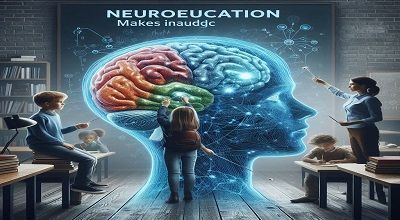Neuroeducation Makes Inroads
Neuroeducation Makes Inroads: Neuroeducation, an interdisciplinary field combining neuroscience, psychology, and education, continues to revolutionize the educational landscape in 2024. By applying insights from brain research to teaching and learning, neuroeducation aims to enhance educational outcomes and foster holistic development. This article explores the latest advancements in neuroeducation, highlighting key trends, methodologies, and practical applications. Additionally, it addresses six frequently asked questions to provide a comprehensive understanding of this evolving field.
The Foundations of Neuroeducation
Neuroeducation seeks to bridge the gap between how the brain learns and how teaching is delivered. Grounded in cognitive neuroscience, it emphasizes the importance of understanding neural mechanisms to optimize educational practices. Key principles include:
- Neuroplasticity: The brain’s ability to reorganize itself by forming new neural connections throughout life, underscoring the potential for lifelong learning.
- Critical Periods: Specific times during development when the brain is particularly receptive to certain types of learning.
- Emotional Regulation: The impact of emotions on cognitive processes and the importance of creating supportive learning environments.
- Individual Differences: Recognizing that each learner’s brain is unique, necessitating personalized educational approaches.
Key Developments in Neuroeducation (2024)
- Integration of Technology:
- Artificial Intelligence (AI) in Classrooms: AI-powered tools are being used to personalize learning experiences, providing real-time feedback and adaptive learning paths tailored to individual student needs.
- Virtual and Augmented Reality (VR/AR): Immersive technologies are creating interactive and engaging learning environments, helping students visualize complex concepts and enhancing experiential learning.
- Focus on Social-Emotional Learning (SEL):
- SEL Programs: Schools are increasingly incorporating SEL programs to help students develop emotional intelligence, resilience, and interpersonal skills.
- Mindfulness and Meditation: Practices aimed at improving concentration, reducing stress, and fostering a positive learning environment are gaining popularity.
- Brain-Based Teaching Strategies:
- Active Learning: Emphasizing hands-on, experiential activities that engage multiple senses to enhance memory retention and understanding.
- Metacognition: Teaching students to think about their thinking processes, encouraging self-regulation and effective learning strategies.
- Teacher Training and Professional Development:
- Neuroscience-Informed Training: Programs designed to equip educators with an understanding of brain-based learning principles and practical applications in the classroom.
- Collaborative Learning Communities: Encouraging educators to share best practices and insights derived from neuroeducation research.
Practical Applications and Case Studies
- Case Study: Personalized Learning in Action:
- School X: Implemented AI-driven personalized learning platforms, resulting in significant improvements in student engagement and academic performance.
- Case Study: VR in Science Education:
- School Y: Utilized VR simulations to teach complex scientific concepts, leading to deeper understanding and increased interest in STEM subjects.
- Case Study: SEL Program Implementation:
- School Z: Introduced a comprehensive SEL curriculum, observing enhanced student well-being, reduced behavioral issues, and improved academic outcomes.
Future Directions and Challenges
- Ethical Considerations:
- Data Privacy: Ensuring the protection of student data in technology-enhanced learning environments.
- Equity: Addressing disparities in access to neuroeducation resources and technologies.
- Ongoing Research:
- Longitudinal Studies: Investigating the long-term effects of neuroeducation interventions on academic and life outcomes.
- Neuroscientific Innovations: Exploring new brain imaging technologies and their potential applications in education.
- Policy Implications:
- Funding: Advocating for increased investment in neuroeducation research and implementation.
- Curriculum Integration: Promoting the inclusion of neuroscience principles in standard educational curricula.
Frequently Asked Questions (FAQs)
- What is neuroeducation?
- Neuroeducation is an interdisciplinary field that combines neuroscience, psychology, and education to enhance teaching and learning by applying insights from brain research.
- How does neuroeducation benefit students?
- Neuroeducation benefits students by providing personalized learning experiences, improving emotional regulation, and fostering a deeper understanding of concepts through brain-based teaching strategies.
- What are some examples of neuroeducation in practice?
- Examples include AI-driven personalized learning platforms, VR simulations for immersive learning, and SEL programs that develop emotional intelligence and resilience.
- How can teachers apply neuroeducation principles in the classroom?
- Teachers can apply neuroeducation principles by using active learning techniques, promoting metacognitive strategies, and creating supportive, emotionally conducive learning environments.
- What are the challenges in implementing neuroeducation?
- Challenges include ethical considerations such as data privacy and equity, as well as the need for ongoing research and policy support to ensure effective and widespread implementation.
- What does the future hold for neuroeducation?
- The future of neuroeducation lies in continued technological integration, ethical and equitable practices, and sustained research efforts to refine and expand its applications in education.
Conclusion
Neuroeducation is making significant inroads in 2024, transforming educational practices and enhancing student outcomes. By leveraging insights from neuroscience, educators can create more effective, personalized, and emotionally supportive learning environments. As the field continues to evolve, ongoing research, ethical considerations, and policy support will be crucial in ensuring that neuroeducation reaches its full potential in shaping the future of education.
